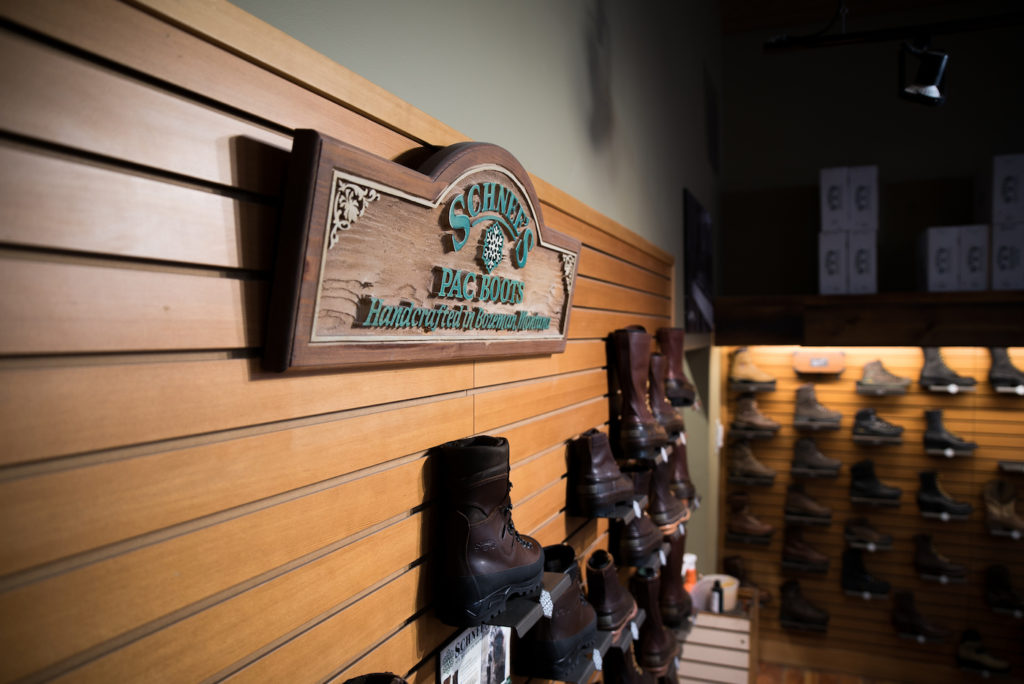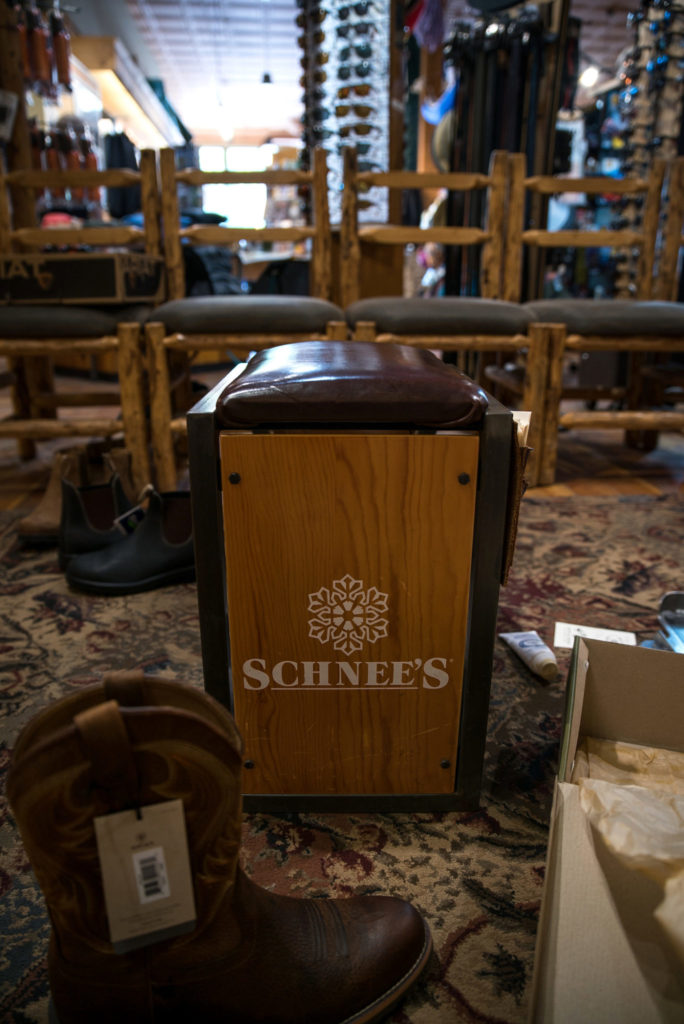Cover Photo Credit Connor Gabbott of Talus Creative.
Since releasing the Art and Science of Boot Fitting podcast a few weeks ago, I’ve been getting a ton of emails and questions about this critical topic. Many of the questions center around what to do if you don’t live close to a store with the expertise like they do at Schnee’s. And this is a great question.
My first response to this question is: define close. In my opinion, driving half a day or more to get to a store with the selection and expertise to allow you to confidently sort out the most important piece of gear you’ll buy in any given season is worth it. Most of us won’t bat an eye at driving that distance to scout out an area, and in my opinion, one’s boots are even more important than a pre-season scouting mission. If you’ve been struggling with boot selection or boot fit, it’s worth your time to make the pilgrimage to a store where they truly understand your needs.
 Photo Credit Connor Gabbott of Talus Creative.
Photo Credit Connor Gabbott of Talus Creative.
Unfortunately, that still leaves many people out in the dark. The harsh truth is there are very few stores in North America that truly know what they’re doing when it comes to boot fitting and even fewer that understand the demands of mountain or backcountry hunting. For most of us, boot shopping is either conducted online or at the best available local option, which usually means a big-box outdoor retailer. And having tried both of those options more times than I can count, I know how frustrating and time-consuming it can be to find the right boots.
So, I decided to focus on how to navigate the uncertain and often frustrating world of boot shopping when you don’t have in-person access to a store like Schnee’s. As grandiose as it may sound, I’m calling these my “Five Commandments of Boot Shopping” and hope that the material will help you save time and money in your search for the right boot or selection of boots for your backcountry and mountain hunting needs.

The Five Commandments of Boot Shopping
1) Verify Customer Service Policies:
- Wearing boots around the store and around your house is insufficient to tell whether they truly work for you or not. At some point, you will need to put on a pack and get the boots dirty. Any store or online retailer that will not work with you to refund or, at minimum replace with store credit a pair of boots that doesn’t pass a field test is not a retailer you should ever buy anything from. I recently went through this with a pair of trail runners I bought from a Canadian based online retailer and made the mistake of not vetting their return policy before I purchased and used the shoes on the trails. I was told “too bad,” and this place has lost a customer for my life. A nearly $200 lesson learned.
2) Where Possible Buy from a Hunting Focused Retailer:
- If the retailer you’re considering has a solid return or exchange policy, then my next recommendation would be to buy from a retailer that considers hunters one of its core customers. For one, your money will go to a business that supports our lifestyle. Two, the staff will understand your needs and be better able to help guide you in your boot selection. Hunters find themselves afield when most people are hanging up their boots for the season, and the demands we face are unique to our community. Many so-called “mountain boots” are not built to handle the demands of a backcountry hunt, so it’s imperative to buy from a retailer that carries brands that will serve you well. Many retailers will have plenty of options to choose from, but a lot of these brands will not survive a season of hunting. For my winter Rocky Mountain goat hunt last year, I purchased a pair of mountain boots from a very well-known brand at one of my local big-box outdoor retailers, and by the end of that five days hunt the soles of the boots were already breaking down. When I took the boots back, the staff told me the boots weren’t built to handle the demands of the terrain I’d used them in. That’s right, a pair of “mountain boots” couldn’t handle five days in the mountains. Luckily, this retailer had a solid return policy.

3) Where Possible Buy Only from Retailers That Consider Themselves Boot Experts:
- Having worked in the foot care industry for more than a decade, I know how challenging boot or shoe fit can be. There are very few retailers out there that truly know how to work with the complexities of the feet. The retailers that do, make the fitting process a core competency of their shopping experience, be that in-person, on the phone, or virtually (online). I have shopped at REI and MEC (like REI but Canadian) on more occasions than I care to admit, and I can promise you that neither of these retailers know, or care, a lick about boot fit. The standard customer interaction at these places is more DIY than anything else. They ask you what size you want, and grab the boot you tell them you want. As confident as you may be in your direction, a true boot fitting focused retailer will ask to confirm your size and make observations about your specific foot anatomy so that if the boot you selected doesn’t work for any reason, they can help point you in another direction. I honestly can’t remember the last time I was asked to get sized properly at one of the big-box retailers or received any form of advice that I would consider knowledgeable. It’s possible to get lucky from time to time, but you’re usually on your own. A simple way to determine—in-person—whether you’re in the right place or not is how many (if any) fitting stools you trip over when walking around the store. The retailers that take boot and shoe fit seriously will always have fitting stools scattered around their floor space. This is a safe indication you’re going to encounter knowledgeable staff that have been trained to deal with all manners of foot related questions. If considering buying online, call the customer service number and ask a few questions that pertain to your needs. If the customer service rep sounds dumbfounded or, at minimum doesn’t offer to find the answer to your questions, move on.
4) Test the Boots Under Field Conditions:
- Assuming you’re able to satisfy points 1 – 3 above, you need to test the boots under field conditions and sooner than later. As good as a boot may feel in the store or at home when you take them out of the box, this is an insufficient test of their comfort, fit, and function where it matters most: in the backcountry. I’ve had countless boots, and other trail shoes feel great at home only to prove utterly useless or unwearable for extended backcountry purposes. To be crystal clear, I am not suggesting you should test the boots for an entire season and then try to return them. There are very few retailers who, for good reason, would be willing to take a pair of boots back months after you purchased them. What I am suggesting is that once the boots have cleared the in-store or at-home trial, you need to get them outside and put them through an initial field test that approximates the demands of the backcountry. If the boots fail the initial test, this does not necessarily mean they’re not going to work. It may mean you just need to put in a little more effort refining the fit and/or components you add to the boots (like insoles or playing with the lacing system). This is what makes point 3 so important. You need to be able to contact the retailer and ideally talk to someone that knows how to troubleshoot the intricacies of boot fit and help you determine whether you need a different boot altogether or simply need to play around with the finer points of boot fitting.

5) Test Multiple Sizes and Models at Once:
- This is a time-saving “hack” more than anything else. Especially if you’re buying online. Yes, it requires you to spend a bit more money at the beginning, but I can assure you, it will save you time and money in the long run. By testing multiple boots and sizes at the same time, you will be better able to drill down on precisely what works for you. Exchanging one boot after another is a time-consuming endeavor, I’ve been there. As you’ll hear if you listen to The Art and Science of Boot Fitting podcast, my two feet are different sizes. This means that finding the right size and fit to satisfy both feet can be a challenge, depending on the brand of boot. This is not uncommon. If I order a pair of boots online, I always order a half-size up and down from what I think my size should be for the given brand. Every brand will fit differently so there’s no way to be sure that the size you wore in your old boots will apply in your new boots. Unless it’s the same brand and model of course. When it comes to boot models, I usually like to test different models at the same time. When an experience is fresh in your mind, you’re better able to determine exactly what you did and didn’t like when testing the boots. Also, in my experience, a lot of hunters “over-boot” themselves. Meaning, they’ve been convinced they need to wear boots far stiffer than they ought to. A stiff, supportive boot has its place, there’s no question about that. But outside of truly extreme terrain and conditions, most hunters can get away with a more flexibly built boot than they think. My advice is to purchase or order multiple models so you can test both a stiff and more flexible boot at home and, assuming they clear the home test, in the field. Wear them around the house, go up and downstairs, just spend weight-bearing time in various models. The more you use them, the more you’ll learn. Many boot-related issues stem from a boot that is simply too stiff for the intended task, and your feet and ankles will get stronger if given the chance. A more flexible boot may result in some soreness and fatigue in the early stages, but if the overall fit is better for your needs, this would be a better choice. Until you test both types of boots, you won’t know whether you can handle a more flexible boot.
I hope this article provided you with some tips and guidance on navigating the often-frustrating process of shopping for new boots. At the end of the day, focus on retailers that stand 100% by their products and their advice and will work with you to find the best boot for your needs. Invest the time in visiting one of these retailers, in-person, if you can. It will be worth the trip. If not, the suggestions I made above will make your shopping experience a little less time-consuming and hopefully get you back to burning some boot leather sooner than later.

